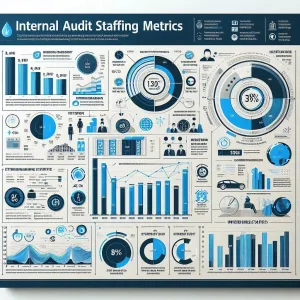Internal auditing is a systematic process that evaluates an organization’s operations, ensuring compliance with established standards and identifying areas for improvement. A quality audit template can be a valuable tool in this process, streamlining tasks and enhancing efficiency. Traditionally, internal audits have relied on manual processes, extensive documentation, and face-to-face interactions. These practices, while effective in their time, often involve significant time and resource investments, making them less adaptable to the fast-paced business environment of today.
As organizations increasingly embrace digital transformation, the landscape of internal auditing is evolving. Quality audit templates have emerged as essential tools in this transition, providing a structured approach to streamline audit processes. These templates not only enhance the efficiency of audits but also ensure that critical quality metrics are consistently monitored and reported. By standardizing the audit process, organizations can better manage their quality assurance efforts and facilitate continuous improvement.
The rapid pace of digital transformation is reshaping how internal audits are conducted. With advancements in technology, such as data analytics, artificial intelligence, and cloud computing, auditors can now access real-time data and insights, allowing for more informed decision-making. This shift not only enhances the accuracy of audits but also enables auditors to focus on strategic areas that drive organizational success. As a result, the integration of quality audit templates into digital auditing practices is becoming increasingly vital, ensuring that organizations remain compliant and competitive in an ever-evolving landscape.
In this blog, we will explore how quality audit templates are adapting to meet the demands of digital transformation, the benefits they offer, and how internal audit leaders and technology officers can leverage these tools to enhance their auditing practices.
Understanding Quality Audit Templates
In the rapidly evolving landscape of internal auditing, quality audit templates have emerged as essential tools that facilitate the auditing process, particularly in the context of digital transformation. These templates serve as structured frameworks that guide auditors in assessing compliance, performance, and operational efficiency within organizations.
Definition and Purpose of Quality Audit Templates
Quality audit templates are systematic documents designed to standardize the audit process. They provide a clear outline of the steps, criteria, and metrics that auditors should follow during an audit. The primary purpose of these templates is to ensure consistency and thoroughness in audit practices, enabling auditors to effectively evaluate an organization’s adherence to established standards and regulations. By utilizing these templates, internal auditors can streamline their workflows, reduce the risk of oversight, and enhance the overall quality of their assessments [1][12].
Components of an Effective Quality Audit Template
An effective quality audit template typically includes several key components:
- Audit Objectives: Clearly defined goals that outline what the audit aims to achieve, such as compliance verification or performance improvement.
- Checklist of Criteria: A comprehensive list of standards and regulations against which the audit will be conducted, ensuring that all relevant areas are covered.
- Data Collection Methods: Guidelines on how to gather necessary information, including interviews, document reviews, and observations.
- Evaluation Metrics: Specific metrics that will be used to assess performance and compliance, allowing for quantitative analysis of findings.
- Reporting Format: A structured format for presenting audit results, which aids in clarity and facilitates communication with stakeholders [3][5][6].
These components work together to create a robust framework that supports auditors in conducting thorough and effective evaluations.
Enhancing Audit Efficiency and Effectiveness
Quality audit templates significantly enhance both the efficiency and effectiveness of the auditing process. By providing a standardized approach, these templates reduce the time spent on planning and executing audits. This efficiency is particularly crucial in the digital age, where organizations face increasing pressure to adapt quickly to changing regulations and market conditions.
Moreover, the use of quality audit templates fosters a culture of continuous improvement within organizations. They allow auditors to identify areas of strength and weakness, facilitating targeted recommendations for enhancing operational processes. This proactive approach not only helps in compliance but also drives organizational performance by aligning audit activities with strategic business objectives [4][7][10].
As internal auditing continues to evolve in response to digital transformation, quality audit templates will play a pivotal role in shaping audit practices. By understanding their definition, components, and benefits, internal audit leaders and technology officers can leverage these tools to enhance their audit processes, ensuring that they remain effective and relevant in a rapidly changing environment.
The Impact of Digital Transformation on Internal Auditing
The landscape of internal auditing is undergoing a significant transformation driven by advancements in technology. As organizations increasingly embrace digital solutions, the traditional methods of conducting audits are evolving to meet the demands of a more complex and data-driven environment. This section explores the key changes brought about by digital transformation in internal auditing practices.
Shift from Traditional Audit Methods to Digital Solutions
- Transition to Digital Tools: Internal auditors are moving away from manual processes and paper-based documentation to digital tools that streamline audit workflows. This shift allows for more efficient data collection, analysis, and reporting, ultimately enhancing the overall audit experience [2].
- Real-Time Monitoring: Digital solutions enable continuous auditing and real-time monitoring of processes, which helps organizations identify issues promptly and take corrective actions before they escalate. This proactive approach contrasts sharply with traditional audits, which often occur at fixed intervals and may miss critical insights [10].
Role of Technology in Enhancing Audit Processes
- Data Analytics: The integration of data analytics into audit practices allows auditors to analyze large volumes of data quickly and accurately. This capability enhances the ability to detect anomalies, trends, and patterns that may indicate risks or inefficiencies within the organization [2].
- Artificial Intelligence (AI): AI technologies are being utilized to automate routine audit tasks, such as data entry and preliminary analysis. This not only reduces the time spent on manual tasks but also allows auditors to focus on more strategic activities, such as risk assessment and advisory roles [14].
- Improved Collaboration: Digital platforms facilitate better communication and collaboration among audit teams and stakeholders. Cloud-based solutions enable auditors to share findings and insights in real-time, fostering a more transparent and responsive audit process [10].
Challenges Faced by Internal Auditors Due to Digital Transformation
- Skill Gaps: As the audit landscape evolves, there is a growing need for auditors to possess advanced technical skills, including proficiency in data analytics and familiarity with digital tools. This shift may create skill gaps within audit teams, necessitating ongoing training and development [2].
- Data Security and Privacy Concerns: The increased reliance on digital solutions raises concerns about data security and privacy. Internal auditors must navigate complex regulatory environments and ensure that their audit practices comply with data protection laws while safeguarding sensitive information [14].
- Integration of New Technologies: Adopting new technologies can be challenging, particularly for organizations with established audit processes. Internal auditors may face resistance to change from stakeholders accustomed to traditional methods, making it essential to manage the transition effectively [10].
The digital transformation of internal auditing presents both opportunities and challenges. By embracing new technologies and adapting audit practices, internal audit leaders and technology officers can enhance the effectiveness and efficiency of their audit processes, ultimately contributing to better organizational governance and risk management.
Adapting Quality Audit Templates to a Digital Environment
As internal auditing evolves in the digital age, it is crucial for audit leaders and technology officers to adapt quality audit templates to meet the demands of a rapidly changing landscape. The integration of technology into audit practices not only enhances efficiency but also improves the overall quality of audits. Here are some key strategies and considerations for updating quality audit templates in this digital environment:
Key Elements to Consider When Adapting Templates for Digital Audits
- Flexibility and Agility: Audit templates must be designed to be flexible, allowing for quick adjustments in response to emerging risks and changes in the business environment. Dynamic audit planning techniques, which emphasize agility, can help auditors adapt their approaches based on real-time data and stakeholder feedback [6].
- Alignment with Digital Processes: It is essential to ensure that audit templates align with the organization’s digital processes and internal controls. Understanding key internal controls and processes is vital for developing audit procedures that effectively link to identified risks [8].
- Stakeholder Engagement: Actively soliciting feedback from stakeholders can drive improvements in audit templates. Engaging with stakeholders helps auditors understand their needs and expectations, which can be incorporated into the template design [7].
Integration of Data Analytics and Automation in Audit Templates
The incorporation of data analytics and automation into audit templates is transforming the way audits are conducted. Here are some ways these technologies can be integrated:
- Data-Driven Insights: Utilizing data analytics allows auditors to analyze large volumes of data quickly, identifying trends and anomalies that may indicate risks. This capability enhances the quality of audits by providing deeper insights into the organization’s operations [13].
- Automated Processes: Automation can streamline repetitive tasks within the audit process, allowing auditors to focus on more complex and value-added activities. For instance, automated sampling techniques can reduce the time spent on sample-based testing, making audits more efficient [12].
- Real-Time Monitoring: Implementing automated tools enables real-time monitoring of internal controls and compliance, ensuring that audits are not only retrospective but also proactive in identifying potential issues.
Examples of Modernized Audit Template Formats
To effectively adapt to a digital environment, organizations can explore various modernized audit template formats, including:
- Cloud-Based Tools: Utilizing cloud-based audit management software allows for greater collaboration among audit teams and stakeholders. These tools often come with built-in analytics capabilities, enabling auditors to access and analyze data from anywhere [10].
- Interactive Dashboards: Modern audit templates can incorporate interactive dashboards that provide visual representations of audit findings and metrics. This format enhances communication and understanding among stakeholders, making it easier to convey complex information.
- Mobile-Friendly Formats: As remote work becomes more prevalent, audit templates should be designed to be mobile-friendly, allowing auditors to access and update templates on-the-go. This flexibility can improve the efficiency of the audit process and facilitate timely decision-making.
Adapting quality audit templates to a digital environment is essential for internal audit leaders and technology officers. By considering key elements such as flexibility, alignment with digital processes, and stakeholder engagement, and by integrating data analytics and automation, organizations can modernize their audit practices. Embracing cloud-based tools and interactive formats will further enhance the effectiveness and efficiency of internal audits in the digital age.
Best Practices for Implementing Updated Quality Audit Templates
As internal auditing evolves in the digital age, the implementation of updated quality audit templates becomes crucial for maintaining effectiveness and relevance. Here are actionable recommendations for internal audit leaders and technology officers to ensure a smooth transition to these new templates:
1. Outline Steps for Effectively Implementing New Quality Audit Templates
- Assess Current Practices: Begin by evaluating existing audit processes and templates to identify gaps and areas for improvement. This assessment should align with the organization’s strategic priorities and risk management efforts, ensuring that the new templates are tailored to meet specific needs [1].
- Engage Stakeholders: Involve key stakeholders, including audit team members and management, in the development and refinement of the new templates. Their insights can provide valuable perspectives on practical challenges and expectations, fostering a sense of ownership and commitment to the new processes [7].
- Pilot Testing: Before full-scale implementation, conduct pilot tests of the new templates in select audit engagements. This allows for real-world feedback and adjustments, ensuring that the templates are user-friendly and effective in achieving audit objectives [9].
- Documentation and Standardization: Ensure that all new templates are well-documented and standardized across the audit function. This promotes consistency and helps auditors understand the expectations and requirements associated with each template [6].
2. Discuss the Importance of Training for Auditors on New Tools and Methodologies
- Comprehensive Training Programs: Develop training programs that cover not only the technical aspects of the new templates but also the underlying methodologies and tools. This holistic approach ensures that auditors are well-equipped to utilize the templates effectively [3].
- Ongoing Support and Resources: Provide continuous support through resources such as user manuals, FAQs, and access to experienced mentors. This can help auditors navigate challenges as they adapt to the new templates and methodologies [7].
- Encourage Knowledge Sharing: Foster an environment of knowledge sharing within the audit team. Regular meetings to discuss experiences with the new templates can facilitate learning and improvement, allowing auditors to share best practices and lessons learned.
3. Highlight the Need for Continuous Improvement and Feedback Loops in Template Design
- Establish Feedback Mechanisms: Create structured feedback loops where auditors can provide input on the usability and effectiveness of the new templates. This feedback is essential for identifying areas for improvement and ensuring that the templates remain relevant as audit practices evolve [10].
- Iterative Design Process: Adopt an iterative approach to template design, where updates and enhancements are made based on auditor feedback and changing organizational needs. This flexibility allows the audit function to adapt quickly to new challenges and opportunities in the digital landscape [2].
- Benchmarking Against Best Practices: Regularly benchmark the quality audit templates against industry best practices and standards. This ensures that the templates not only meet internal requirements but also align with external expectations and regulatory standards [1].
By following these best practices, internal audit leaders and technology officers can effectively implement updated quality audit templates that enhance the audit process, drive continuous improvement, and support the organization’s digital transformation journey.
Future Trends in Internal Auditing
As the landscape of internal auditing continues to evolve, driven by rapid technological advancements, it is essential for audit leaders and technology officers to stay informed about the emerging trends that will shape the future of their practices. The integration of innovative technologies such as blockchain, machine learning, and artificial intelligence (AI) is not just a trend; it is a transformative force that is redefining the role of internal auditors and the methodologies they employ.
Emerging Technologies Impacting Internal Auditing
Blockchain: This technology offers a decentralized and secure way to record transactions, which can enhance transparency and traceability in audits. By utilizing blockchain, auditors can access real-time data, reducing the time spent on data verification and increasing the accuracy of audits [3].
Machine Learning and AI: These technologies are revolutionizing data analysis in auditing. Machine learning algorithms can analyze vast amounts of data to identify patterns and anomalies that may indicate risks or fraud. This capability allows auditors to focus on high-risk areas and make more informed decisions [1][9].
Robotic Process Automation (RPA): RPA can automate repetitive tasks, such as data entry and report generation, freeing up auditors to concentrate on more strategic activities. This not only enhances efficiency but also improves the overall quality of audits by minimizing human error [10].
Data Analytics: The use of advanced data analytics tools enables auditors to gain deeper insights into organizational performance and risk management. By leveraging data analytics, internal auditors can provide more value-added services to their organizations, moving beyond traditional compliance checks [11][12].
The Future Role of Internal Auditors
In a technology-driven environment, the role of internal auditors is expected to evolve significantly. Auditors will need to become proficient in the technologies that are reshaping their field. This includes:
- Advisory Role: As organizations increasingly rely on technology, internal auditors will transition from traditional compliance roles to strategic advisors. They will be expected to provide insights on risk management and technology implementation, ensuring that organizations are not only compliant but also resilient [6][8].
- Continuous Monitoring: With the advent of real-time data access through technologies like blockchain, auditors will shift towards continuous monitoring of processes and controls. This proactive approach will allow for immediate identification of issues, enhancing the overall effectiveness of audits [1][14].
- Collaboration with IT: Internal auditors will need to work closely with IT departments to understand the implications of new technologies on audit practices. This collaboration will be crucial for developing effective audit strategies that align with technological advancements [10][15].
Importance of Agility and Adaptability
As the auditing landscape continues to change, the ability to adapt and remain agile will be paramount for internal audit functions. Key considerations include:
- Embracing Change: Internal audit teams must be open to adopting new technologies and methodologies. This willingness to embrace change will be essential for staying relevant and effective in a rapidly evolving environment [2][5].
- Training and Development: Continuous professional development will be necessary to equip auditors with the skills needed to navigate new technologies. Organizations should invest in training programs that focus on emerging technologies and their application in auditing [4][11].
- Flexible Audit Frameworks: Developing flexible audit frameworks that can quickly adapt to new technologies and business practices will be critical. This flexibility will enable internal auditors to respond effectively to changes in the business environment and stakeholder expectations [12][15].
The future of internal auditing is poised for significant transformation as technology continues to advance. By embracing emerging technologies, redefining their roles, and fostering agility, internal auditors can enhance their effectiveness and provide greater value to their organizations in the digital age.
Conclusion
As we navigate the complexities of the digital age, the evolution of quality audit templates is not just beneficial but essential for the internal audit profession. The rapid advancements in technology, including artificial intelligence, blockchain, and data analytics, are reshaping how audits are conducted and how auditors interact with data and clients. This transformation necessitates a reevaluation of existing audit practices to ensure they remain relevant and effective in a fast-paced environment [5][15].
Internal audit leaders must embrace a proactive mindset, recognizing that adapting quality audit templates is crucial for maintaining audit quality and relevance. By integrating new technologies and methodologies, audit teams can enhance their ability to provide valuable insights and ensure compliance with evolving regulatory standards [3]. This proactive approach will not only improve the efficiency of audit processes but also position internal audit as a strategic advisor within organizations [13].
We encourage all internal audit leaders and technology officers to assess their current auditing practices critically. This includes evaluating the effectiveness of existing quality audit templates and identifying areas for improvement. By updating these templates to reflect the demands of digital transformation, organizations can better navigate the complexities of the modern audit landscape and enhance their overall governance and risk management frameworks [10][11].
In conclusion, the future of internal auditing lies in the ability to adapt and innovate. By prioritizing the evolution of quality audit templates, internal audit functions can ensure they remain indispensable in driving organizational success in the digital era.
Find out more about Shaun Stoltz https://www.shaunstoltz.com/about/
This post was written by an AI and reviewed/edited by a human.



